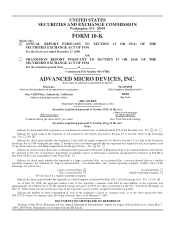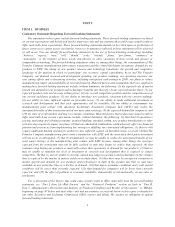AMD 2008 Annual Report Download - page 17
Download and view the complete annual report
Please find page 17 of the 2008 AMD annual report below. You can navigate through the pages in the report by either clicking on the pages listed below, or by using the keyword search tool below to find specific information within the annual report.as engineering and digital content creation and other information technology infrastructure applications such as
intensive Web serving, virtualization and messaging.
AMD Opteron processors also allow enterprise customers to efficiently implement virtualization across their
businesses. Virtualization is the use of software to allow multiple discrete operating systems and application
environments to share a single physical computer by providing the illusion that each operating system has full
control over the underlying hardware. By enabling different operating systems and applications to run on the
same server, virtualization offers the benefit of consolidating workloads and reducing hardware requirements,
which can also reduce power, cooling and system management costs.
In November 2008, we introduced 45 nanometer quad-core AMD Opteron processors. These processors
incorporated four processor cores on a single die of silicon and added a 6MB shared L3 cache. The increased
cache helps increase the speed of memory-intensive applications. Quad-core AMD Opteron processors offer
improved overall performance on many different applications compared to the dual-core AMD Opteron
processors by executing more operations simultaneously during each clock cycle and by improving
performance-per-watt, which can reduce the operational costs related to power usage. Quad-core AMD Opteron
processors also feature improved virtualization performance and a variety of power-saving technologies,
including AMD CoolCore™technology, which we designed to reduce energy consumption by turning off unused
parts of the processor when they are idle, enhanced AMD PowerNow! technology, which we designed to allow
each core to vary its clock frequency depending on the performance requirements of the application being
supported, and dual dynamic power management, which provides an independent power supply to the cores and
the memory controller.
Notebook Microprocessors. Our microprocessors for notebook PCs consist of AMD Turion™X2 Ultra,
AMD Turion X2, mobile AMD Athlon™, mobile AMD Sempron™and the AMD Athlon Neo processors. We
designed our mobile processor products for high-performance, longer battery life and wireless connectivity.
AMD Turion X2 Ultra dual-core mobile processors are our most advanced dual-core processor family for
notebook PCs. We designed this technology to enable leading-edge graphics for the more visual experience
provided by the Microsoft®Windows Vista™operating system, longer battery life, and enhanced security and
compatibility with the latest wireless technologies and graphics solutions. In addition, the process used to
manufacture AMD Turion X2 Ultra processors results in a more thermally efficient processor and reduced power
consumption.
In June 2008, we launched the “Puma” platform, which was our code name for our mainstream notebook
platform. The Puma platform incorporates the AMD Turion X2 Ultra dual-core mobile processor for advanced
multi-tasking, the ATI Mobility Radeon™HD 3000 Series of graphics processors for advanced 3D graphics and
the AMD 7-Series chipset with ATI Radeon HD 3200 integrated graphics. Our Puma platform products offer
enhanced high definition, or HD, visual performance with full 1080p playback capability as well as wireless
solutions that provide enhanced range and rapid data transfer and power management technologies that maximize
battery life.
In January 2009, we launched the “Yukon” platform, which was our code name for our ultrathin notebook
platform. The Yukon platform incorporates the AMD Athlon Neo processor with ATI Radeon™ X1250
integrated graphics and ATI Mobility Radeon™ HD 3410 discrete graphics. The Yukon platform offers a
complete PC experience at lower price points.
Desktop Microprocessors. Our microprocessors for desktop PCs consist primarily of the following tiered
product brands: AMD Phenom™II, AMD Phenom, AMD Athlon and AMD Sempron processors. All AMD
desktop microprocessors are based on AMD Direct Connect Architecture.
In March 2008, we introduced the AMD Phenom X3 8000 series triple-core processors designed for gamers
and digital media enthusiasts at mainstream prices. AMD Phenom triple core processors can improve
7
























